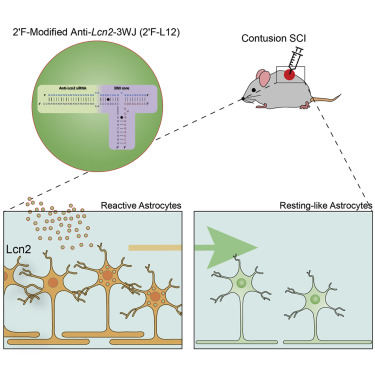Molecular Therapy - Nucleic Acids ( IF 6.5 ) Pub Date : 2017-11-24 , DOI: 10.1016/j.omtn.2017.11.008 Jayden A Smith 1 , Alice Braga 2 , Jeroen Verheyen 1 , Silvia Basilico 1 , Sara Bandiera 3 , Clara Alfaro-Cervello 1 , Luca Peruzzotti-Jametti 1 , Dan Shu 4 , Farzin Haque 4 , Peixuan Guo 4 , Stefano Pluchino 1

|
In response to injuries to the CNS, astrocytes enter a reactive state known as astrogliosis, which is believed to be deleterious in some contexts. Activated astrocytes overexpress intermediate filaments including glial fibrillary acidic protein (GFAP) and vimentin (Vim), resulting in entangled cells that inhibit neurite growth and functional recovery. Reactive astrocytes also secrete inflammatory molecules such as Lipocalin 2 (Lcn2), which perpetuate reactivity and adversely affect other cells of the CNS. Herein, we report proof-of-concept use of the packaging RNA (pRNA)-derived three-way junction (3WJ) motif as a platform for the delivery of siRNAs to downregulate such reactivity-associated genes. In vitro, siRNA-3WJs induced a significant knockdown of Gfap, Vim, and Lcn2 in a model of astroglial activation, with a concomitant reduction in protein expression. Knockdown of Lcn2 also led to reduced protein secretion from reactive astroglial cells, significantly impeding the perpetuation of inflammation in otherwise quiescent astrocytes. Intralesional injection of anti-Lcn2-3WJs in mice with contusion spinal cord injury led to knockdown of Lcn2 at mRNA and protein levels in vivo. Our results provide evidence for siRNA-3WJs as a promising platform for ameliorating astroglial reactivity, with significant potential for further functionalization and adaptation for therapeutic applications in the CNS.
中文翻译:

用于改善星形胶质细胞反应性的 RNA 纳米疗法。
作为对中枢神经系统损伤的反应,星形胶质细胞进入一种称为星形胶质细胞增生的反应状态,这在某些情况下被认为是有害的。活化的星形胶质细胞过度表达包括胶质纤维酸性蛋白 (GFAP) 和波形蛋白 (Vim) 在内的中间丝,从而产生抑制神经突生长和功能恢复的纠缠细胞。反应性星形胶质细胞还分泌炎症分子,如脂质运载蛋白 2 (Lcn2),它使反应性持续存在并对中枢神经系统的其他细胞产生不利影响。在此,我们报告了使用包装 RNA (pRNA) 衍生的三向连接 (3WJ) 基序作为传递 siRNA 以下调此类反应性相关基因的平台的概念验证。体外, siRNA-3WJs 诱导Gfap , Vim的显着抑制, 和Lcn2在星形胶质细胞激活模型中,同时蛋白质表达减少。Lcn2的敲低还导致反应性星形胶质细胞的蛋白质分泌减少,从而显着阻碍了静止星形胶质细胞中炎症的持续存在。脊髓挫伤小鼠病灶内注射抗Lcn2 -3WJ 导致体内mRNA 和蛋白质水平的 Lcn2 敲低。我们的研究结果为 siRNA - 3WJs 作为改善星形胶质细胞反应性的有前途的平台提供了证据,具有进一步功能化和适应 CNS 治疗应用的巨大潜力。











































 京公网安备 11010802027423号
京公网安备 11010802027423号